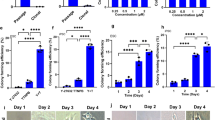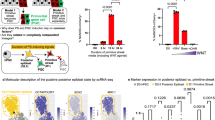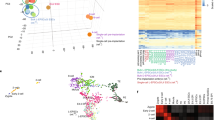Abstract
Human embryonic stem cells (hESCs) have unique self-renewal and differentiation properties, which are experimentally measured using functional assays. hESC cultures are known to be heterogenous, but whether subsets of cells contribute differently to functional assays has yet to be examined. Here, using clonal tracking by retroviral integration, we analyzed in situ the propensity of individual hESCs to contribute to different functional assays. We observed different clonal distributions in teratomas versus in vitro differentiation assays. Some hESC subsets apparently contributed substantially to lineage-specific embryoid body differentiation and lacked clonogenic capacity, although they had self-renewal ability. In contrast, other subsets of self-renewing hESCs with clonogenic ability contributed to teratoma formation but were less frequently observed after in vitro differentiation. Our study suggests that assays used to measure pluripotency may detect distinct subsets of hESCs. These findings have direct implications for hESC-based therapies that may be optimized based on such functional assays.
This is a preview of subscription content, access via your institution
Access options
Subscribe to this journal
Receive 12 print issues and online access
$259.00 per year
only $21.58 per issue
Buy this article
- Purchase on Springer Link
- Instant access to full article PDF
Prices may be subject to local taxes which are calculated during checkout






Similar content being viewed by others
References
Reynolds, B.A. & Weiss, S. Clonal and population analyses demonstrate that an EGF-responsive mammalian embryonic CNS precursor is a stem cell. Dev. Biol. 175, 1–13 (1996).
Purton, L.E. & Scadden, D.T. Limiting factors in murine hematopoietic stem cell assays. Cell Stem Cell 1, 263–270 (2007).
Thomson, J.A. et al. Embryonic stem cell lines derived from human blastocysts. Science 282, 1145–1147 (1998).
Itskovitz-Eldor, J. et al. Differentiation of human embryonic stem cells into embryoid bodies compromising the three embryonic germ layers. Mol. Med. 6, 88–95 (2000).
Trounson, A. The production and directed differentiation of human embryonic stem cells. Endocr. Rev. 27, 208–219 (2006).
Lensch, M.W., Schlaeger, T.M., Zon, L.I. & Daley, G.Q. Teratoma formation assays with human embryonic stem cells: a rationale for one type of human-animal chimera. Cell Stem Cell 1, 253–258 (2007).
Murry, C.E. & Keller, G. Differentiation of embryonic stem cells to clinically relevant populations: lessons from embryonic development. Cell 132, 661–680 (2008).
Amit, M. et al. Clonally derived human embryonic stem cell lines maintain pluripotency and proliferative potential for prolonged periods of culture. Dev. Biol. 227, 271–278 (2000).
Stewart, M.H. et al. Clonal isolation of hESCs reveals heterogeneity within the pluripotent stem cell compartment. Nat. Methods 3, 807–815 (2006).
Pyle, A.D., Lock, L.F. & Donovan, P.J. Neurotrophins mediate human embryonic stem cell survival. Nat. Biotechnol. 24, 344–350 (2006).
Watanabe, K. et al. A ROCK inhibitor permits survival of dissociated human embryonic stem cells. Nat. Biotechnol. 25, 681–686 (2007).
Xu, C. et al. Feeder-free growth of undifferentiated human embryonic stem cells. Nat. Biotechnol. 19, 971–974 (2001).
Bendall, S.C. et al. IGF and FGF cooperatively establish the regulatory stem cell niche of pluripotent human cells in vitro. Nature 448, 1015–1021 (2007).
Keller, G., Paige, C., Gilboa, E. & Wagner, E.F. Expression of a foreign gene in myeloid and lymphoid cells derived from multipotent haematopoietic precursors. Nature 318, 149–154 (1985).
Dick, J.E., Magli, M.C., Huszar, D., Phillips, R.A. & Bernstein, A. Introduction of a selectable gene into primitive stem cells capable of long-term reconstitution of the hemopoietic system of W/Wv mice. Cell 42, 71–79 (1985).
Guenechea, G., Gan, O.I., Dorrell, C. & Dick, J.E. Distinct classes of human stem cells that differ in proliferative and self-renewal potential. Nat. Immunol. 2, 75–82 (2001).
Palmer, T.D., Takahashi, J. & Gage, F.H. The adult rat hippocampus contains primordial neural stem cells. Mol. Cell. Neurosci. 8, 389–404 (1997).
Morshead, C.M., Craig, C.G. & van der Kooy, D. In vivo clonal analyses reveal the properties of endogenous neural stem cell proliferation in the adult mammalian forebrain. Development 125, 2251–2261 (1998).
Wang, Z. & Jaenisch, R. At most three ES cells contribute to the somatic lineages of chimeric mice and of mice produced by ES-tetraploid complementation. Dev. Biol. 275, 192–201 (2004).
Schmidt, M. et al. A model for the detection of clonality in marked hematopoietic stem cells. Ann. NY Acad. Sci. 938, 146–155 (2001).
Mazurier, F., Gan, O.I., McKenzie, J.L., Doedens, M. & Dick, J.E. Lentivector-mediated clonal tracking reveals intrinsic heterogeneity in the human hematopoietic stem cell compartment and culture-induced stem cell impairment. Blood 103, 545–552 (2004).
Osafune, K. et al. Marked differences in differentiation propensity among human embryonic stem cell lines. Nat. Biotechnol. 26, 313–315 (2008).
Schmidt, M. et al. Polyclonal long-term repopulating stem cell clones in a primate model. Blood 100, 2737–2743 (2002).
Schmidt, M. et al. High-resolution insertion-site analysis by linear amplification–mediated PCR (LAM-PCR). Nat. Methods 4, 1051–1057 (2007).
Blum, B. & Benvenisty, N. Clonal analysis of human embryonic stem cell differentiation into teratomas. Stem Cells 25, 1924–1930 (2007).
Blum, B., Bar-Nur, O., Golan-Lev, T. & Benvenisty, N. The anti-apoptotic gene survivin contributes to teratoma formation by human embryonic stem cells. Nat. Biotechnol. 27, 281–287 (2009).
Baum, C., Schambach, A., Bohne, J. & Galla, M. Retrovirus vectors: toward the plentivirus? Mol. Ther. 13, 1050–1063 (2006).
Ma, Y., Ramezani, A., Lewis, R., Hawley, R.G. & Thomson, J.A. High-level sustained transgene expression in human embryonic stem cells using lentiviral vectors. Stem Cells 21, 111–117 (2003).
Schmidt, M. et al. Detection and direct genomic sequencing of multiple rare unknown flanking DNA in highly complex samples. Hum. Gene Ther. 12, 743–749 (2001).
Eisen, M.B., Spellman, P.T., Brown, P.O. & Botstein, D. Cluster analysis and display of genome-wide expression patterns. Proc. Natl. Acad. Sci. USA 95, 14863–14868 (1998).
de Hoon, M.J., Imoto, S., Nolan, J. & Miyano, S. Open source clustering software. Bioinformatics 20, 1453–1454 (2004).
Saldanha, A.J. Java Treeview–extensible visualization of microarray data. Bioinformatics 20, 3246–3248 (2004).
Acknowledgements
M.H.S. was supported by a Canadian Institutes of Health Research Canada Graduate Scholarship doctoral award. This work was supported by Canadian Institutes of Health Research, Ontario Ministry of Research Innovation and a Canada Research Chair award to M.B. We thank T. Schuesler and C. von Kalle for providing and troubleshooting the LAM-PCR methods and applications to hESC lines.
Author information
Authors and Affiliations
Contributions
M.H.S. designed, performed, and analyzed all experiments, and wrote and revised the manuscript. S.C.B. contributed intellectual input to design and analysis of experiments and results. M.L.-M. performed all FACS. M.B. provided intellectual support toward design and interpretation of the results, and wrote and revised the manuscript.
Corresponding author
Ethics declarations
Competing interests
The authors declare no competing financial interests.
Supplementary information
Supplementary Text and Figures
Supplementary Figures 1–11 and Supplementary Tables 1–4 (PDF 3951 kb)
Rights and permissions
About this article
Cite this article
Stewart, M., Bendall, S., Levadoux-Martin, M. et al. Clonal tracking of hESCs reveals differential contribution to functional assays. Nat Methods 7, 917–922 (2010). https://doi.org/10.1038/nmeth.1519
Received:
Accepted:
Published:
Issue Date:
DOI: https://doi.org/10.1038/nmeth.1519
This article is cited by
-
Lentiviral and targeted cellular barcoding reveals ongoing clonal dynamics of cell lines in vitro and in vivo
Genome Biology (2014)
-
Nanog-dependent feedback loops regulate murine embryonic stem cell heterogeneity
Nature Cell Biology (2012)
-
Defining pluripotency
Nature Methods (2010)



